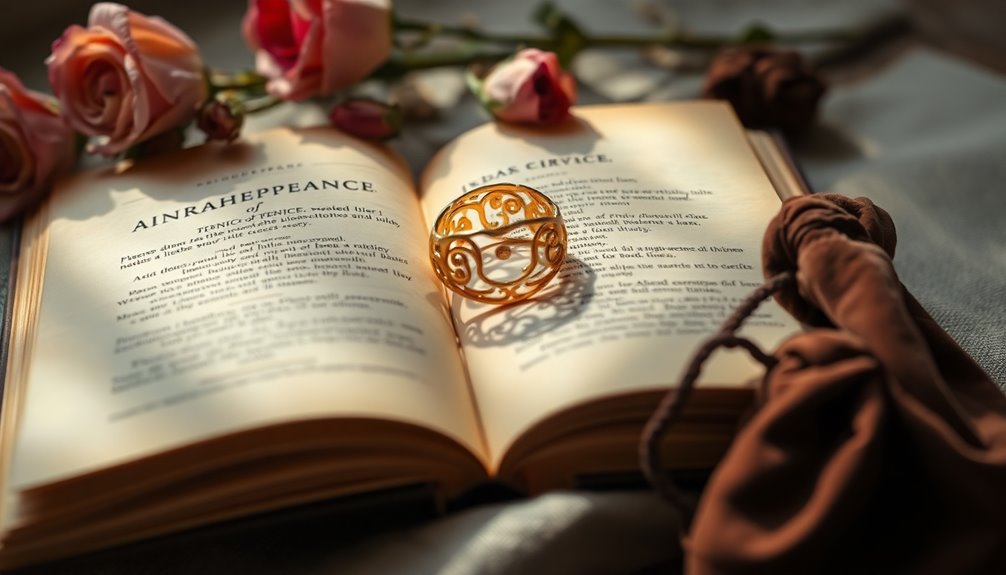Symbolism is like a secret code that makes stories come alive! When you spot a symbol, it often represents deeper ideas, helping you connect more with the characters and themes. For example, a green light might stand for dreams or hope. These symbols can spark emotions, as they remind you of your own experiences and feelings. Plus, they tie different parts of the plot together, making everything clearer and more exciting. Analyzing symbolism helps you see the story's richness and explore the author's message. Keep going, and you'll uncover even more amazing insights about how symbolism shapes our favorite tales!
Key Takeaways
- Symbolism enhances reader engagement by enabling exploration of complex ideas and themes, making narratives more immersive.
- Recurring symbols evoke emotional responses, fostering deeper connections between readers and characters.
- Symbols provide coherence within the story, tying various plot elements together for a unified experience.
- Personal and cultural interpretations of symbols enrich readers' emotional resonance and understanding of universal themes.
- Analyzing symbols encourages deeper reflection, revealing layers of meaning beyond superficial readings of the text.
Impact of Symbolism on Reader Engagement

Symbolism serves as a powerful tool that greatly boosts reader engagement. When you immerse yourself in a story filled with symbolism, you're invited to explore complex ideas. Instead of just reading, you're interpreting layers of meaning hidden within the narrative. This journey can make the characters and themes come alive in a whole new way!
Think about it: symbols can evoke emotional responses. When you see a recurring symbol, it connects you deeply to what's happening. You might feel joy, sadness, or excitement as you relate to the characters' experiences. This connection fosters a sense of discovery as you uncover what the symbols mean to you personally.
Moreover, symbols create coherence in a story. They help tie different parts of the plot together, making the whole experience richer. As you engage with these symbols, you're not just a passive reader; you're actively participating in a secret language between you and the writer.
This interaction sparks your imagination, encouraging you to form your own personal interpretations. So, the next time you read, look for those symbols, and let them guide you through a delightful adventure in understanding!
Symbolism and Emotional Resonance

When you encounter symbols in literature, they often resonate on an emotional level, connecting you to universal themes and experiences. These symbols can spark feelings and thoughts, making you feel closer to the story. They help you understand complex themes and allow you to see deeper meanings behind the words.
Here are a few ways symbols engage readers:
- Personal Connections: Symbols can remind you of your own life or memories, creating a unique bond with the narrative.
- Cultural Reflections: Different cultural backgrounds can influence how you interpret symbols, adding richness to your experience.
- Empathy Boost: When symbols evoke emotional responses, they encourage you to understand characters better and feel what they feel.
This literary device fosters empathy and provokes thought, inviting you to reflect on your own emotions. You might find yourself thinking about the deeper meanings behind a simple object or action.
Analyzing Symbols in Literature

As you immerse yourself in a text, paying attention to symbols can reveal a deeper understanding of the narrative. Symbolism adds layers of meaning, making stories more engaging and exciting. When analyzing symbols, look for objects, actions, or characters that seem to carry deeper significance. These symbols can change based on context, like the historical background or the author's intent.
You'll notice that authors often use recurring symbols to highlight central themes. This can enhance your understanding of the emotional and thematic depth of the story. Each symbol can evoke different emotional responses, so take a moment to reflect on how they make you feel.
However, be careful! Misinterpretations can occur if you overlook the author's intent or ignore the broader context. This can lead to superficial readings, missing the richness of the text. Instead, dive deeper into your interpretation of the symbols. By doing so, you connect personally with the story, revealing its true meaning.
When you analyze symbols thoughtfully, you'll discover a world of insights and joy in literature that goes beyond the surface!
Examples of Symbolism in Classic Works

Numerous classic works of literature provide rich examples of symbolism that deepen the reader's experience. These symbols help convey important themes and emotions, making the stories more impactful.
Here are some exciting examples of symbolism you might encounter:
- In To Kill a Mockingbird, the mockingbird represents innocence and goodness. This teaches us to protect those who do no harm.
- The green light in The Great Gatsby symbolizes Gatsby's dreams. It shows how elusive the American Dream can be.
- In Lord of the Flies, Piggy's glasses symbolize hope and intellect. They highlight the fragile nature of civilization.
Other classic works also use powerful symbols. For instance, the red A in *The Scarlet Letter* signifies both sin and resilience, while Moby Dick's white whale represents obsession and the struggle against nature.
Each of these symbols represents something deeper, helping you connect with the characters and themes. When you notice these symbols, they enhance your understanding and enjoyment of the story.
This impact on the reader makes classic works unforgettable, encouraging you to think about their messages long after you've finished reading.
Resources for Writers Exploring Symbolism

Writers seeking to enrich their narratives with symbolism can tap into a variety of valuable resources that inspire creativity and deepen thematic exploration. One fantastic option is the One Stop for Writers Theme and Symbolism Thesaurus. This resource offers a treasure trove of symbols to spark ideas and inform your stories.
If you're looking for practical techniques, consider engaging with Domestika Courses. These courses are designed to help you incorporate symbolism effectively, boosting your creative writing skills.
Another great option is the MasterClass Annual Membership, where you can learn from renowned authors. You'll gain insights into the art of using symbolism in storytelling.
Don't forget the power of community feedback! Sharing your symbolic choices with others can lead to constructive criticism, helping you understand the impact of symbolism on your writing process.
You can also explore articles and resources focused on symbolism to deepen your knowledge and gather strategies for weaving symbols into your narratives. Additionally, incorporating essential oils for toothache relief can serve as a metaphor for healing and comfort in your stories.
With these resources for writers, you'll be well-equipped to create stories that resonate with readers, filled with rich, meaningful symbolism. Immerse yourself and enjoy the journey of exploring symbolism in your writing!
Frequently Asked Questions
How Does Symbolism Affect the Audience?
Symbolism affects you as an audience by making stories more exciting and relatable. When you see a symbol, like a red rose, it might remind you of love or friendship. This connection encourages you to think deeper about the story.
Symbols can also help you understand big ideas without needing lots of explanations. You share these meanings with others, creating a wonderful bond over the story you all enjoy together!
What Is the Effect of Symbol on the Reader?
Imagine walking through a magical forest, where each tree whispers secrets and every flower holds a story.
When you read, symbols act like these hidden treasures, sparking your imagination. They make you think deeply, connecting feelings and ideas.
You'll find yourself reflecting on your own life as you uncover what these symbols mean. This journey adds excitement to your reading, making the story richer and more meaningful, inviting you to explore every detail.
How Does Symbolism Affect the Viewer?
Symbolism can really change how you see a story! When you spot a symbol, it can make you feel excited or even curious. It helps you connect with the characters and their adventures.
You might notice familiar symbols that relate to your own life, making everything more meaningful. Plus, symbols can highlight important ideas, like good versus evil.
What Does Symbolism Show the Reader?
Symbolism shows you the hidden treasures of a story! It turns everyday objects into powerful messages.
When you spot a symbol, you're diving into deeper meanings. It helps you connect with characters and their journeys, making the story feel alive and exciting.
Plus, symbols can be like breadcrumbs, guiding you through themes and emotions. So, keep your eyes peeled! Each symbol you discover adds layers of understanding to your reading adventure.
Conclusion
Symbolism is like a treasure map in a story, guiding you to deeper meanings and feelings. You might think symbols are just confusing, but they actually help you connect with characters and their journeys. When you spot a symbol, it sparks your imagination and makes the story come alive. So, next time you read, keep an eye out for those special symbols! They'll enrich your experience and make you see the story in a whole new light.











